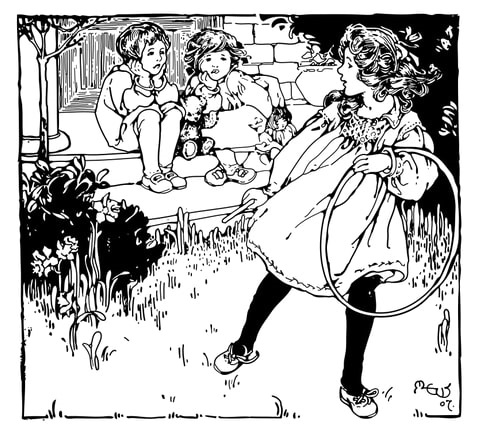Introduction: In this article, Jessica Edwards begins a new series exploring the pastimes and toys our ancestors enjoyed when they were children. Jessica has had a lifelong interest in her family’s history – especially on her father’s side, which goes back to the first settlers in Pennsylvania, Jamestown and New England – and has documented and added more than 21,000 people to her family tree!
Years ago, in a class I taught on genealogy, I was asked by someone how to “take the dryness out of our family tree.” I thought a moment and replied, “Bring the relatives alive” and said that in the next class I would cover how to do this. In that next class I showed my students things they could learn about their relatives’ lives that would take them from statistics on paper to “living people” – like finding out what songs they may have listened to, what things they could have done in their “free time,” what was going on both in their community, nationally, and in the world that may have affected their lives.

At the end of January 2018 my mother died from brain cancer, and the best thing she left me and my siblings (I feel) was contained in a simple spiral-bound notebook – her autobiography. Years before I had asked her and my father to fill out books that contained basic questions (places, dates, etc.) for your father or mother (depending on the volume) to answer about their lives. She filled hers out almost immediately, but it took almost two years for my father to fill his out (it is in his own handwriting, which I cherish because he would rarely write anything, as he felt ashamed that he “wasn’t better educated”), and then she sent them to me as a Christmas gift.
I had thought the matter closed, but when I shared with her some of the suggestions I had for my genealogy class, one of my ideas inspired her, and she ran with it. That idea was this: lists of questions people could answer about different parts of their lives to create an autobiography. I suggested my students choose one or two questions a day to answer in their journals so that they didn’t get caught in the “writer’s block” many people get when trying to do something like this, and then build on them as much as possible.
My mother picked up a spiral-bound notebook and began answering questions. She said that while writing, she would have memories suddenly pop up that would supplement her original answers, so she’d go back and write them in the sides and in between lines so that things stayed fairly in order. When she died, she requested I be given the notebook and I set about typing a copy of it for my brother, sister, and cousins (many of my mother’s answers involved their parents’ early lives, so I thought my cousins would like to learn about that time, as well as discover a different side of their parents – as I did with my mother).
I supplemented the typed version with photos of the relatives she spoke about, and photos of the fashions she described, to give those who read it in future generations an idea of what she was talking about. I also added copies of the recipes for food she described so that they could taste what she tasted. Once this was all done, I sent copies to everyone in the family. (I’m glad I did, because recently my computer had a surge and wiped it all out – so a cousin sent it back to me.)
One of the largest parts of my mother’s autobiography dealt with her early life and what chores she had to do, how she celebrated holidays, how she spent her free time, and the toys she received and played with as well as the games she played. This made me curious about how other children spent their free time, so I began to research this subject for children who lived during the period of roughly 1700 until 1950. That research led to this upcoming series of articles.
Why did I choose that stretch of time? Around 1950 our society started changing from work-oriented life for children to one where they had more free time. It was also the era when we started producing more formal games and toys so that play time was more structured.
In the time period I selected, children’s days often began at first light, when they might have to get water from the well, lay a fire, bring in wood, and boil water to help begin the breakfast. Children would then milk the cows and collect eggs. Remember, back then there was rarely electricity. Lighting came from candles or lanterns in the pre-electricity days, each of which added additional chores by having to create or maintain them. Everyday chores took longer back then without electricity-powered machines (for example, doing laundry for the family might take an entire day or two, and then things needed to be ironed which would take more time).
In examining children’s pastimes and toys from 1700 to 1950, we’re looking at a time when children worked more and had less free time than children today. By studying how they played, we can learn about an aspect of our ancestors’ lives not often dealt with in genealogy, and help bring those names and dates on the family tree back to life.
More to come!
